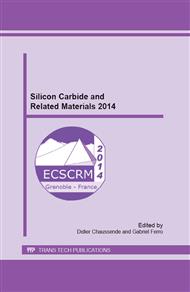p.733
p.737
p.741
p.745
p.749
p.753
p.757
p.761
p.765
High-Mobility SiC MOSFETs with Chemically Modified Interfaces
Abstract:
Alkali (Rb, Cs) and alkaline earth elements (Sr, Ba) provide SiO2/SiC interface conditions suitable for obtaining high metal-oxide-semiconductor field-effect-transistor (MOSFET) channel mobility on the 4H-SiC Si-face (0001), without the standard nitric oxide (NO) anneal. The alkali elements Rb and Cs result in field-effect mobility (μFE) values >25 cm2/V.s, and the alkaline earth elements Sr and Ba resulted in higher μFE values of 40 and 85 cm2/V.s, respectively. The Ba-modified MOSFETs show a slight decrease in mobility with heating to 150 °C, as expected when mobility is not interface-trap-limited, but phonon-scattering-limited. The interface state density is lower than that obtained with nitric oxide (NO) passivation. Devices with a Ba interface layer maintain stable mobility and threshold voltage under ±2 MV/cm gate bias stress at 175 °C, indicating no mobile ions.
Info:
Periodical:
Pages:
749-752
Citation:
Online since:
June 2015
Keywords:
Price:
Сopyright:
© 2015 Trans Tech Publications Ltd. All Rights Reserved
Share:
Citation:


